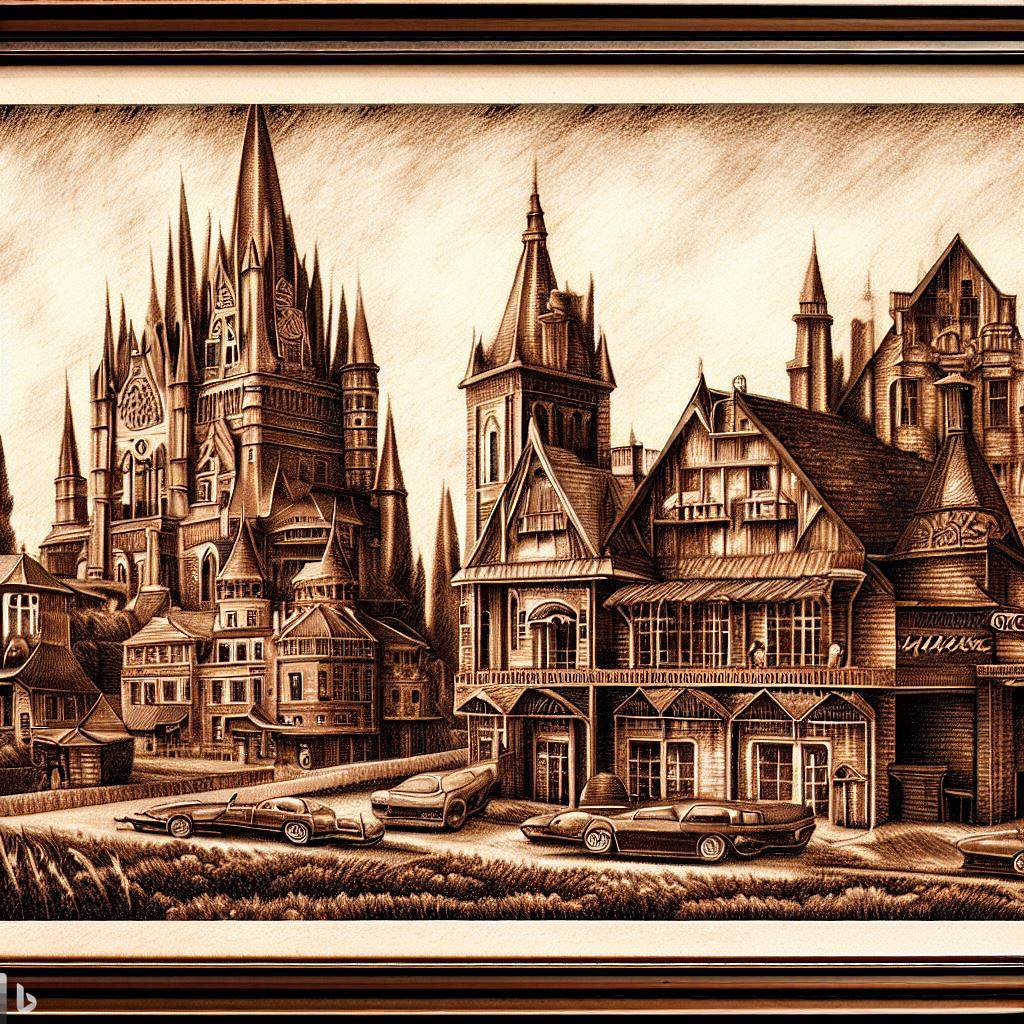Architectural Pyrography: Burning Buildings, Homes and Landmarks into Wood
Architecture’s inspiring shapes, lines, and details translate beautifully into pyrography art. Wood burnings allow you to recreate and honor memorable buildings, historic homes, iconic landmarks, and other meaningful structures with artistic precision.
Whether interpreting famous cathedrals, college campuses, lighthouses, barns, cabins, or personal dwellings, architectural subjects provide endless possibilities for imaginative pyrographic compositions. This guide covers techniques for burning architectural features in realistic depth and dimension. Let’s explore setting architecture’s permanence into impermanent artful wood!
Planning Your Architectural Pyrography
Careful planning helps architectural pyrography compositions come together cleanly before burning:
Gather Quality References
Study high resolution, multi-angle photos of the building for accurately burning every side, angle and detail. Use a mix of closeups and wider shots.
Map the Structure
Sketch structural diagrams marking key features like windows, doors, roof lines, chimneys, railings, etc. Note their placement to replicate the architecture logically when burning.
Establish Scale
Determine the level of realism and relative proportions for your wood piece’s size. Will it be miniaturized folk art or large grand manor? Enlarge/shrink references as needed.
Transfer Complex Outlines
Use grid, tracer, or projector methods to transfer intricate architectural outlines onto the wood surface for precision. Carbon paper also works for simpler shapes.
Plan Burn Stages
Strategically plan which sections to burn first, second, third etc so overlapping areas don’t get unintentionally burned as you build the composition. Think through the layers.
Basic Architectural Elements to Master
Practice burning these foundational features well to realistically convey a sense of place:
Windows
The shapes, muntin patterns, and glazing all provide clues to a building’s age and style. Master squared, arched, circular, bay, stained glass, dormer and other window varieties.
Doors
Think about the wood tones, panels, hardware, steps, trim, etc. that characterize doors. Center, off-center, double, arched, folding, french, patio – study their details.
Roofs
The roof shape and covering impacts the building’s personality. Hipped, gabled, mansard, flat, tented, gambrel, conical, dormer – each has unique lines and angles. Reference photos closely.
Bricks/Siding
Bricks can display various bonding patterns, textures, and shading. Wood or shingle siding has boards, corner joints, graining, and weathering. These surfaces wrap the structure’s volume.
Chimneys
Chimneys punctuate rooflines and provide comforting hearthside warmth. Capture their masonry, crowns, pots, flues, and weathered character.
Shading Techniques for Dimension
Thoughtful shading makes architectural elements look three dimensional rather than flat cutouts. Useful techniques include:
Burn Layers for Gradual Tones
Build depth by burning lighter base layers first, then adding progressively darker layers for shadows. Let each layer fully cool before the next application.
Directional Hatching
Use diagonal hatching strokes travelling the same direction as light would logically strike that surface. This helps surfaces curve realistically.
Stippling/Crosshatching
Vary stippling patterns and crosshatching angles to suggest complex textures like roof shingles, siding woodgrain, brick, stone, concrete, etc.
Burn Contours First
Focus initially on burning distinct outlines for key contours – this helps place shadows correctly later. Build upon defined structure.
Cast Shadows
Add secondary shadows where surfaces or elements would logically block light. For example, a jutting roofline casting a shadow onto the side of a house below it.
Window Light
Make windows glow by leaving wood around them lighter. For night scenes, do the opposite – make windows darker voids against the lighter walls.
Compositional Tips
Thoughtful composition allows architectural elements to come together in balanced wooden scenes:
Lead the Eye
Use bridges, fences, walls, gates, landscaping, people, vehicles, etc. to guide the viewer’s eye logically through the scene you create.
Utilize Negative Space
Don’t overcrowd. Allow breathing room around buildings. Use open sky, fields, roads, water, foreground, and background intentionally.
Overlap for Depth
Overlap some elements like trees partially covering a house for additional depth perception. Mimic real life sightlines.
Perspective Lines
Use vanishing points on the horizon line to make structures recede realistically into space. Consult perspective drawing techniques.
Vary Foreground to Background
Gradually change focus, details, contrast, colors, and sharpness from up close foreground subjects out towards softer distant backgrounds.
Consider Lighting
Direct sunlight versus diffused overcast lighting will impact shadows and contrast. Nighttime scenes with illuminated windows and streetlights make dramatic moods. Choose lighting purposefully.
Mix Natural and Built Features
Interplay surrounding nature and landscaping with the architecture itself. This helps anchor the structure within a believable sensory environment.
Architecture Themes to Inspire You
Consider what architectural styles and subjects resonate for potential burning projects:
Childhood Home
Recreate details of the house you grew up in from memories and photos for a nostalgic momento.
College Campus/School
Feature classic campus buildings, dorms, libraries, quads, and landmarks remembered fondly from your education days.
Places of Worship
Cathedrals, temples, churches, and mosques can provide inspiring gothic archways, spires, rose windows, and ornate facades to pyrograph.
Rural Barns and Silos
Rustic cabins, barns, fences, and farm buildings make wonderful pyrography subjects celebrating homesteading life.
Lighthouses and Piers
Capture the stoic yet scenic presence of coastal lighthouses and weathered wharfs to commemorate seaside travels.
City Skylines
Depict famous cityscapes like Manhattan, Paris, London, etc. with iconic architecture, bridges, towers, and waterways.
Historical Sites
Memorialize places of personal meaning like ancestral villages, monuments, museums, forts, cemeteries, ruins, etc.
Commercial Buildings
Banks, theaters, hotels, offices, train stations, mills, factories, and shops also provide unique architectural styles to appreciate.
Let the architecture that shaped your life or community become the basis for your artistic pyro tributes. The buildings tell stories as rich as wood’s grain.
